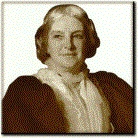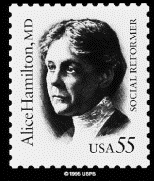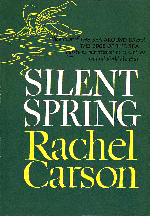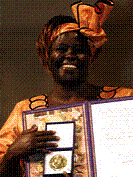As many of us already know, 1970 was the founding of Earth Day. Earth Day ushered in the concept of environmentalism into the world’s consciousness in a big way. The horrors of Cleveland's burning toxics in the Cuyahoga River, flocks of oil-smeared birds along Santa Barbara beaches, the Union Carbide factory poison gas leaks killing and maiming thousands in Bhopal India, and then the Exxon Valdez oil spill all became front page news. The public was shifting to a new consciousness. Protecting their families and children from negative environmental impacts became a priority. But environmental challenges and concerns have been around long before the launch of the modern environmental movement. The contemporary environmental movement arose primarily from concerns in the late 19th century about the protection of the dwindling countryside in Europe and the wilderness in the United States and the health consequences of pollution during the Industrial Revolution.1
Many amazing women have been in the forefront of connecting “environmental justice and environmental health issues” to issues of everyday life. For women, the health of families and the health of the environment are closely interlinked.
 Octavia Hill (1838 - 1912)2 was founder of the most influential English society for preservation, the National Trust. As "the first woman environmentalist of significance", she saw the link between social reform and environmental protection. She worked closely with her sister Miranda Hill (1836-1910), for the preservation of open spaces. She pioneered slum improvement, anti-smoke exhibitions and helped protect many areas of London, especially Parliament Hill.3
Octavia Hill (1838 - 1912)2 was founder of the most influential English society for preservation, the National Trust. As "the first woman environmentalist of significance", she saw the link between social reform and environmental protection. She worked closely with her sister Miranda Hill (1836-1910), for the preservation of open spaces. She pioneered slum improvement, anti-smoke exhibitions and helped protect many areas of London, especially Parliament Hill.3
 During the typhoid fever epidemic in Chicago in 1902, Alice Hamilton (1869-1970), founder of occupational medicine and the first woman professor at Harvard Medical School, made a connection between improper sewage disposal and the role of flies in transmitting the typhoid fever. Her findings led to reorganization of the Chicago Health Department. She then noted that the health problems of many of the immigrant poor were due to unsafe conditions and noxious chemicals, and especially lead dust. There were no protections for workers from lead dust or chemical exposures. Nineteenth-century laborers faced a variety of work-related ailments: from rheumatism and pneumonia to lead palsy and carbon monoxide poisoning. Yet governments rarely regulated workplace conditions and the United States lagged far behind industrialized European nations in such regulation. Employers routinely fired sick workers and replaced them with new ones looking for jobs. Dr. Hamilton became director of the Occupational Disease Commission when it was created by the governor of Illinois in 1910. It was the first such commission in the world. 4
During the typhoid fever epidemic in Chicago in 1902, Alice Hamilton (1869-1970), founder of occupational medicine and the first woman professor at Harvard Medical School, made a connection between improper sewage disposal and the role of flies in transmitting the typhoid fever. Her findings led to reorganization of the Chicago Health Department. She then noted that the health problems of many of the immigrant poor were due to unsafe conditions and noxious chemicals, and especially lead dust. There were no protections for workers from lead dust or chemical exposures. Nineteenth-century laborers faced a variety of work-related ailments: from rheumatism and pneumonia to lead palsy and carbon monoxide poisoning. Yet governments rarely regulated workplace conditions and the United States lagged far behind industrialized European nations in such regulation. Employers routinely fired sick workers and replaced them with new ones looking for jobs. Dr. Hamilton became director of the Occupational Disease Commission when it was created by the governor of Illinois in 1910. It was the first such commission in the world. 4
 In Japan, Michiko Ishimure5 was a shy housewife from Minamata who was concerned about the plight of the villagers, who became ill from ingesting high levels of mercury. Minamata was a beautiful and pristine poor fishing and farming center. When one of Japan's pioneer chemical companies set up a chemical plant in 1908 – it transformed into a chemical industrial complex. The methyl-mercury poisoning in Minamata was traced to the release of methyl mercury from the Chisso chemical plant in Minamata Bay. High levels of mercury were found in the local fish as early as 1953 and was causing illness among the local people consuming the fish. Children were becoming sick, babies were born disfigured, and elderly persons were exhibiting strange symptoms that the villagers referred to as the "dancing cat," "high-collar" (i.e., modern), "civilization" or "mysterious" disease. The puzzling "cat's dance disease" that spread through Minamata , caused frenzied cats to die or drown themselves. When Michiko heard that a young woman her own age had died of Minamata Disease she decided to visit the city hospital and see the victims herself. Her first visit was such a shock that she was "ill and weak for six months." After talking with many others who had fallen ill and were dying she was moved to write her first account of the toxic effect of mercury poisoning (1960)-- Cruel Tales of Japan: Modern Period. The public and government did not immediately take action, but Ishimure persevered with organizing a photo exhibition to bring the horrors of the disease to the world and she continued with her writing on the issue. In her book Kukai Jodo—Waga Minamata (Pure Land— Poisoned Sea), published in 1968, she described the ways that Minamata Disease represented the sickness of Japanese society. Ishimure explained the ways that industrialization was itself an illness, resulting in an alienation of the Japanese from their roots. The book received nationwide attention and aroused concern and support for victims of Minamata Disease.
In Japan, Michiko Ishimure5 was a shy housewife from Minamata who was concerned about the plight of the villagers, who became ill from ingesting high levels of mercury. Minamata was a beautiful and pristine poor fishing and farming center. When one of Japan's pioneer chemical companies set up a chemical plant in 1908 – it transformed into a chemical industrial complex. The methyl-mercury poisoning in Minamata was traced to the release of methyl mercury from the Chisso chemical plant in Minamata Bay. High levels of mercury were found in the local fish as early as 1953 and was causing illness among the local people consuming the fish. Children were becoming sick, babies were born disfigured, and elderly persons were exhibiting strange symptoms that the villagers referred to as the "dancing cat," "high-collar" (i.e., modern), "civilization" or "mysterious" disease. The puzzling "cat's dance disease" that spread through Minamata , caused frenzied cats to die or drown themselves. When Michiko heard that a young woman her own age had died of Minamata Disease she decided to visit the city hospital and see the victims herself. Her first visit was such a shock that she was "ill and weak for six months." After talking with many others who had fallen ill and were dying she was moved to write her first account of the toxic effect of mercury poisoning (1960)-- Cruel Tales of Japan: Modern Period. The public and government did not immediately take action, but Ishimure persevered with organizing a photo exhibition to bring the horrors of the disease to the world and she continued with her writing on the issue. In her book Kukai Jodo—Waga Minamata (Pure Land— Poisoned Sea), published in 1968, she described the ways that Minamata Disease represented the sickness of Japanese society. Ishimure explained the ways that industrialization was itself an illness, resulting in an alienation of the Japanese from their roots. The book received nationwide attention and aroused concern and support for victims of Minamata Disease.
 In the U.S., an amazing woman had the courage to stand up to the Chemical Industry with her research in hand, Rachel Carlson (1907-1964), a marine biologist and author, transformed America with her book Silent Spring. Published in 1962, Carlson’s Silent Spring is widely credited with being the single most important book in launching today's environmental movement.In her book Silent Spring, Carlson pointed out the problems of pesticides and how they were disrupting basic biological processes and persisting in the environment. Despite protest by the Chemical and Pesticide industry, she brought attention to the recklessness with which pesticides were being utilized. Silent Spring showed how DDT entered the food chain and accumulated in the fatty tissues of both animals and humans. “A single application on a crop”, she wrote, “killed insects for weeks and months, and not only the targeted insects but countless more, and remained toxic in the environment even after it was diluted by rainwater”. Thanks to Carson the world woke up to the fact that DDT and other pesticides had irrevocably harmed birds and animals and had contaminated the entire world food supply.
In the U.S., an amazing woman had the courage to stand up to the Chemical Industry with her research in hand, Rachel Carlson (1907-1964), a marine biologist and author, transformed America with her book Silent Spring. Published in 1962, Carlson’s Silent Spring is widely credited with being the single most important book in launching today's environmental movement.In her book Silent Spring, Carlson pointed out the problems of pesticides and how they were disrupting basic biological processes and persisting in the environment. Despite protest by the Chemical and Pesticide industry, she brought attention to the recklessness with which pesticides were being utilized. Silent Spring showed how DDT entered the food chain and accumulated in the fatty tissues of both animals and humans. “A single application on a crop”, she wrote, “killed insects for weeks and months, and not only the targeted insects but countless more, and remained toxic in the environment even after it was diluted by rainwater”. Thanks to Carson the world woke up to the fact that DDT and other pesticides had irrevocably harmed birds and animals and had contaminated the entire world food supply.
The book's most haunting and famous chapter, "A Fable for Tomorrow," depicted a nameless American town where all life -- from fish to birds to apple blossoms to human children -- had been "silenced" by the insidious effects of DDT. The "silent spring" was her metaphor for the destruction humans were wreaking on their environment. After President John F. Kennedy read her work, he instructed his Science Advisory Committee to investigate. Despite the powerful objections by the chemical industry of her work and writings, The SAC panel confirmed her results in 1963. May 2007 marks the 100th anniversary of the birth of Rachel Carson!6
 In 2004 another amazing woman who has worked on the frontlines of her community for environmental protection and democracy made a worldwide splash. For the first time the Nobel Peace Prize was given to someone acting outside of the traditional pursuit to end armed conflicts. The Nobel Peace Prize was awarded to Dr. Wangari Maathai which marked a new approach for the Nobel Peace Prize. The incorporation of an environmental theme was a first and interpreted the 1895 will of Swedish philanthropist Alfred Nobel7, in an exciting new way. Awarded the peace prize "for her contribution to sustainable development, democracy and peace," she has also contributed greatly to advancing women's education and empowerment, democratization and sustainable development in Kenya and worldwide.
In 2004 another amazing woman who has worked on the frontlines of her community for environmental protection and democracy made a worldwide splash. For the first time the Nobel Peace Prize was given to someone acting outside of the traditional pursuit to end armed conflicts. The Nobel Peace Prize was awarded to Dr. Wangari Maathai which marked a new approach for the Nobel Peace Prize. The incorporation of an environmental theme was a first and interpreted the 1895 will of Swedish philanthropist Alfred Nobel7, in an exciting new way. Awarded the peace prize "for her contribution to sustainable development, democracy and peace," she has also contributed greatly to advancing women's education and empowerment, democratization and sustainable development in Kenya and worldwide.
Dr. Maathai, the first African woman to win the Nobel Peace Prize was praised by the awarding committee as "a source of inspiration for everyone in Africa fighting for sustainable development, democracy and peace"8
In 1977 Dr. Maathai founded the Green Belt Movement in Kenya and inspired women across her country to plant trees to combat soil erosion from massive deforestation that had already taken place. Facing intense clashes with the government throughout the years, including being jailed for her work and her outspoken voice for the environment, democracy, and the rights of women and the poor, Dr. Maathai and the GBM continued to carry on their work. Today, the movement has transcended national boundaries and some 100,000 people have planted 30 million trees. Dr. Maathai has also.
Nowadays, the political climate has changed a great deal in Kenya, Democratic reforms have been displacing corrupt practices and In December 2002, Dr. Maathai was elected to the Parliament of Kenya, and is currently serving as Assistant Minister for Environment, Natural Resources and Wildlife, a position she was appointed to by the President. She is now seen as a governmental participant rather than its rival On receiving the news of being awarded the Nobel Peace Prize, 2004 Dr. Wangari stated, "It is evident that many wars are fought over resources which are now becoming increasingly scarce. If we conserved our resources better, fighting over them would not then occur…so, protecting the global environment is directly related to securing peace…those of us who understand the complex concept of the environment have the burden to act. We must not tire, we must not give up, we must persist."9
Countless women in communities around the world are following in the footsteps of these environmental SHEROES. They work tirelessly to quell the deterioration of the environment and natural resources. They work against the odds to change the consequences of that deterioration. They take a stand for economic and social development that is earth friendly and that protects the health and quality of life that is core to healthy families and the well being of communities everywhere.
Only a few women have been mentioned here, but thousands are working around the world on the frontlines of peace, justice, and environmental and social renewal. When women are enabled to participate in or provide guidance in the management of the environment, families and whole societies benefit. But women worldwide still engage in an upward battle to access the necessary training, information and services required to secure a foothold in environmental and social policy-making — especially at the local level, where resources are most limited.
Our organization Women’s Global Green Action Network aims to change that by linking and empowering grassroots women leaders around the world. It is evident that the power of women will make the shifts that will steer humanity back to working in balance with the natural world that supports us.
This is the first of a series of articles on issues and information for women on the Environment examining the interactions between the problems facing the world -- approaches to peace, security, development and the environment.
